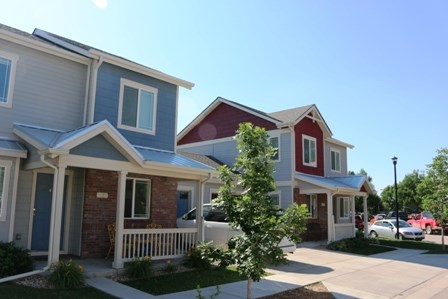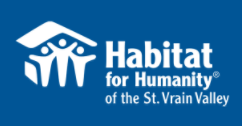This content was originally published by the Longmont Observer and is licensed under a Creative Commons license.
Habitat for Humanity was started on a community farm outside of Americus, Georgia. It was created by Millard and Linda Fuller in 1976. Their Vision is a simple one. Simply stated its "A world where everyone has a decent place to live."

Here in Longmont, the non-profit organization calls itself Habitat for Humanity of the St. Vrain Valley. Their latest project, being coordinated by Rebecca Shannon, is a duplex and a triplex (5 homes total) just Southeast of the intersection of Ken Pratt Parkway and S. Pratt Parkway. On our visit, there were about 60 people actively building on site. A dozen or so of their own staff as well as about 45 volunteers from Americorps. Habitat for Humanity recruits Americorp folks for up to a year of service helping on active build sites, such as the one in Longmont (more on that below). During the life of the project, they are helped by a variety of organizations working on the buildings, such as local churches, mosques (in communities that have them) as well as synagogue's pitch in to help. They also have business groups from small local banks to Fortune 500 companies help with the building. Many of these businesses do both volunteering and funding.
Clive Rainey, Habitat for Humanity's first volunteer, says that one of the things they do is give people an honorable way to get rid of their excess resources and that people need capital, not charity. What they're doing, really, is to create safe, secure and affordable housing to strengthen families who are spending as much as 40% or 50% of their income on housing, putting them on the edge. Habitat for Humanity helps them redirect their families money that would normally be spent on housing for things like savings, dealing with emergencies and education. Enabling a family to secure affordable housing also helps people's kids do better in school and even eat healthier. It let's, for instance, a single mom go back to school to improve her education and get more and better work opportunities.
It also helps adds to the overall community by doing things like paying property taxes, utilities and supporting local infrastructure. It's well known that people that own their own homes are more invested in their towns and care more about what's going on around them such as local elections, what's going on in the schools and how the business community is faring. They, as homeowners, are simply more engaged in the community as a whole.

Habitat for Humanity is in 70 countries building housing and helping to create more 'healthy houses' in poorer countries. Creating healthier houses is achieved by providing basics like water filters, better latrines and better cooking facilities that can eliminate dozens of diseases. This helps more kids live better lives and by virtue of being healthier, helps them improve time in school, education levels, and gives them better working opportunities.
The St. Vrain Habitat is one of about 1500 in the US and has been operating in the area for about 30 years. They've built 78 homes and performed 24 critical repairs, especially after floods. They operate within the St. Vrain Valley School District (Longmont, Lyons, Erie, Dacono, Frederick, and Firestones) and they tie to international affiliates (building over 30 houses overseas) as well as partnering with these groups. For instance, working with international partners, they brought volunteers from Paraguay to help with the critical repair work after Longmont's floods in 2013.
This week, they are doing a Build-a-thon.. a week of intense building with 45 Americorp members. Apparently, you can do quite a bit with forty-five - twenty-year-olds. They started with a foundation last week and now (about 6 days later) have a complete duplex with a roof, blue board, house wrap and they are putting in window frames at the time of our visit. Americorps is a national service program. About 500 serve with Habitat for Humanity around the US, and 3 serve with the local group here in Longmont. They get a stipend, which unfortunately isn't enough to live on in our high-cost area, so they are also given housing. They all work full time on Habitat projects while here.
Many of these Americorp members go on to join Habitat for Humanity groups throughout the United States when their terms with Americorp is done.
Each affiliate is independent, do their own fundraising and build what their community needs. They only build for people that have lived in Longmont for at least a year. They're independent in the sense they have to build for high winds, extreme temperatures as well as following all local zoning regulations. Since the cost of land is high, they build more dwellings like townhomes and duplexes vs. single family homes.
Some of their staff are professional contractors that lead the efforts. Of the 60 people on site today about 5 are paid staff that know how to oversee the building efforts.

They don't give away houses. They sell them to families that are spending more than 30% of their income on their housing and that they can repay an affordable mortgage. They sell the houses at cost because they have mostly volunteers build them.
There are three basic criteria for being chosen as a person getting one of these houses:
1) Need -The percentage of income spent on housing is high. At least 30% and often much higher.
2) Willingness to pay -they have an income and the ability to pay the mortgage.
3) The ability to partner -they have to put in 250 hours for single parent households and 500 hours for two-parent households. This can be done as sweat equity by working on the house site- their own house and a neighboring house or volunteering at the ReStore; kids can help at events and film festivals and by maintaining higher grade point averages.
No waiting lists are kept since it can take 12-18 months to complete a volunteer built home and people's circumstances change.
They get funding from multiple sources. There isn't much, if any, government funding. Most of their funding comes from business sponsorships, church sponsorships, grants and special projects like 'the house that beer built'. which was built by the local breweries in Longmont (money and people volunteering).
The houses are 3 bedroom and about 1200 SF. They have a partnership with Whirlpool on a national level. The cabinets are made in a prison jobs program out of Canon City and as many materials as possible are purchased from US manufacturers. Their contractors, such as electricians and plumbers, provide discounted services that help keep the costs down.
The payments on the houses are determined by the families income at the time they move in. They calculate the mortgage and HOA. The mortgage for these houses are usually 30 years. The amount doesn't change once set. They are sold for, in this case, $150K, but market rate is a little less than twice that. To keep things equitable, they have a 'soft' second mortgage that is the difference between what the family pays for the house and the actual market value of the house. This allows the family, if they need to move for some reason (job changes, family needs, etc.), to still sell the house, but to not overly profit from the low cost they bought it for. This also provides protection for the market value of other local non-Habitat for Humanity houses nearby. So far, they have had no foreclosures.

There is a discussion on how to keep the houses in the 'affordable housing' area (the current model only really takes care of the first buyer of the house); for instance, one option might be that they're required to make it available to another qualified Habitat for Humanity family when the time to sell comes.
One important thing is that they build their houses with aesthetics in mind so they fit into the neighborhood. The last thing Habitat for Humanity wants is for the neighbors to say 'darn, now I live next to one of those 'affordable houses'. In our own humble estimation, the finished products actually look as good, or maybe even better, than the commercially built houses in the area.
If you're interested in donating, in volunteering or just learning more, feel free to contact Rebecca Shannon, Habitat for Humanities outreach and volunteer manager. She can be reached at [email protected], 303-682-2485 x102 or their offices at 303 Atwood Street, Longmont, CO 80501.
https://youtu.be/XW3q8ZDiZgg



